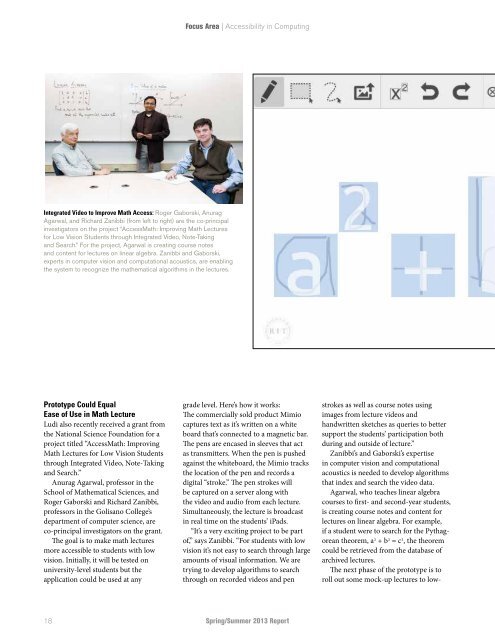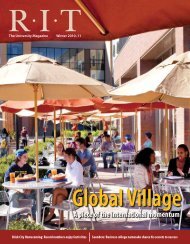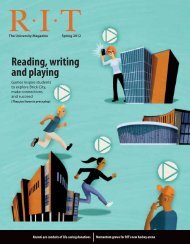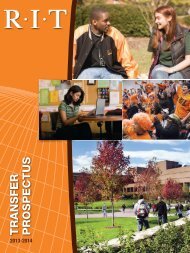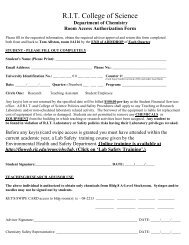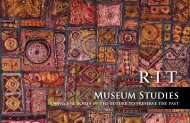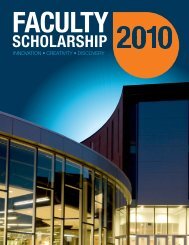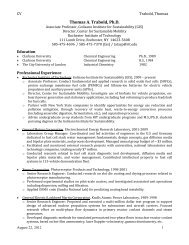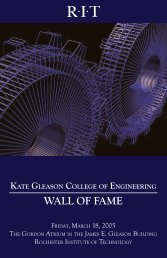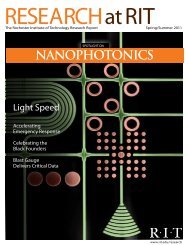Spring / Summer 2013 - Rochester Institute of Technology
Spring / Summer 2013 - Rochester Institute of Technology
Spring / Summer 2013 - Rochester Institute of Technology
Create successful ePaper yourself
Turn your PDF publications into a flip-book with our unique Google optimized e-Paper software.
Focus Area | Accessibility in Computing<br />
Integrated Video to Improve Math Access: Roger Gaborski, Anurag<br />
Agarwal, and Richard Zanibbi (from left to right) are the co-principal<br />
investigators on the project “AccessMath: Improving Math Lectures<br />
for Low Vision Students through Integrated Video, Note-Taking<br />
and Search.” For the project, Agarwal is creating course notes<br />
and content for lectures on linear algebra. Zanibbi and Gaborski,<br />
experts in computer vision and computational acoustics, are enabling<br />
the system to recognize the mathematical algorithms in the lectures.<br />
Prototype Could Equal<br />
Ease <strong>of</strong> Use in Math Lecture<br />
Ludi also recently received a grant from<br />
the National Science Foundation for a<br />
project titled “AccessMath: Improving<br />
Math Lectures for Low Vision Students<br />
through Integrated Video, Note-Taking<br />
and Search.”<br />
Anurag Agarwal, pr<strong>of</strong>essor in the<br />
School <strong>of</strong> Mathematical Sciences, and<br />
Roger Gaborski and Richard Zanibbi,<br />
pr<strong>of</strong>essors in the Golisano College’s<br />
department <strong>of</strong> computer science, are<br />
co-principal investigators on the grant.<br />
The goal is to make math lectures<br />
more accessible to students with low<br />
vision. Initially, it will be tested on<br />
university-level students but the<br />
application could be used at any<br />
grade level. Here’s how it works:<br />
The commercially sold product Mimio<br />
captures text as it’s written on a white<br />
board that’s connected to a magnetic bar.<br />
The pens are encased in sleeves that act<br />
as transmitters. When the pen is pushed<br />
against the whiteboard, the Mimio tracks<br />
the location <strong>of</strong> the pen and records a<br />
digital “stroke.” The pen strokes will<br />
be captured on a server along with<br />
the video and audio from each lecture.<br />
Simultaneously, the lecture is broadcast<br />
in real time on the students’ iPads.<br />
“It’s a very exciting project to be part<br />
<strong>of</strong>,” says Zanibbi. “For students with low<br />
vision it’s not easy to search through large<br />
amounts <strong>of</strong> visual information. We are<br />
trying to develop algorithms to search<br />
through on recorded videos and pen<br />
strokes as well as course notes using<br />
images from lecture videos and<br />
handwritten sketches as queries to better<br />
support the students’ participation both<br />
during and outside <strong>of</strong> lecture.”<br />
Zanibbi’s and Gaborski’s expertise<br />
in computer vision and computational<br />
acoustics is needed to develop algorithms<br />
that index and search the video data.<br />
Agarwal, who teaches linear algebra<br />
courses to first- and second-year students,<br />
is creating course notes and content for<br />
lectures on linear algebra. For example,<br />
if a student were to search for the Pythagorean<br />
theorem, a 2 + b 2 = c 2 , the theorem<br />
could be retrieved from the database <strong>of</strong><br />
archived lectures.<br />
The next phase <strong>of</strong> the prototype is to<br />
roll out some mock-up lectures to low-<br />
18<br />
<strong>Spring</strong>/<strong>Summer</strong> <strong>2013</strong> Report


